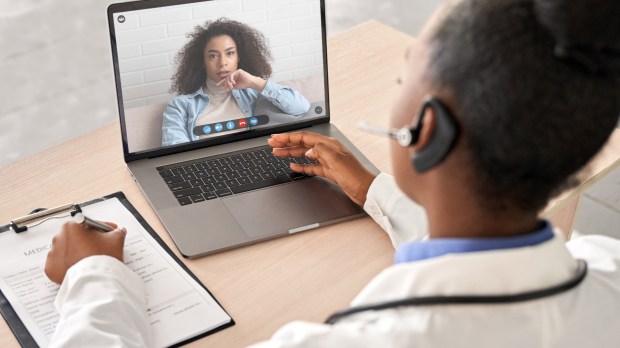In the ongoing fallout from this year’s Supreme Court decision to overturn Roe v. Wade, some states are banning abortion altogether, while pro-choice advocates are seeking ways to get around some prohibitions.
In Arizona, a group has devised a way to get abortion pills to pregnant women through telehealth sessions so that they won’t run afoul of a recently restored ban on most abortions in the state.
But two physicians who lead a medical organization have warned against taking the abortion pill – especially without medical supervision, which is becoming more and more common.
The two doctors, who are affiliated with the American Association of Pro-Life Obstetricians and Gynecologists (AAPLOG), say that increasing reliance on “medical abortions,” especially if done along with telemedicine visits rather than in-person examinations, will result in more complications and possibly more maternal deaths.
How it’s done
Medical abortion is basically a two-step procedure. In the most common practice, a woman first takes mifepristone, which blocks the hormone progesterone, causing the lining of the uterus to thin and preventing the embryo from staying implanted and growing. Then the mother takes misoprostol, which causes the uterus to contract and expel the embryo through the vagina.
During the COVID-19 pandemic, the FDA relaxed the requirement that medical abortion be done under the supervision of a physician. Rather than having to be examined in person and take the first pill in the presence of a doctor, a pregnant woman could do so through telehealth sessions. Last December, the FDA made the change permanent.
“The push for telehealth distribution, or even pharmacy distribution, without a physical exam is something that’s going to cause an increase in harm for women,” said Dr. Donna Harrison, Chief Executive Officer of AAPLOG. “There’s real risk involved for women, and the abortion industry is downplaying those risks.”
What could go wrong?
One risk is misdating the pregnancy, which is dangerous because medical abortion is meant for pregnancies that are 10 weeks gestation or less.
“The only way you can accurately date a pregnancy that early in a pregnancy is by having an ultrasound,” Harrison said. Obviously, that’s not something that can be done through a telemedicine session.
For one thing, it’s important because sometimes medical abortions fail, and the abortion needs to be completed surgically.
“If you have a pregnancy that is 49 days – that is, seven weeks or less – from the first day of the last menstrual period, then your chances of needing a surgical completion are about 1 out of 20,” Harrison said in an interview. “But if you have a pregnancy that is just a few weeks later, like 13 or beyond, your chances of needing surgical completion are 1 out of 3.”
Ectopic pregnancies
Dr. Christina Francis, the incoming CEO of AAPLOG, added that in telehealth sessions, women are not being screened appropriately for ectopic pregnancies, which occur in one out of every 50 pregnancies.
“You cannot adequately rule out an ectopic pregnancy simply by talking to a woman and asking her about symptoms and risk factors,” Francis said. “She actually needs an exam and an ultrasound to rule it out.”
The danger here is that a medical abortion will not end an ectopic pregnancy, she said. The pregnancy will continue to progress, sometimes unknown to the woman. If and when the embryo ruptures the fallopian tube, which is where ectopic pregnancies usually lodge, the woman might think the symptoms are merely those she was told to expect from the medical abortion. She won’t seek medical care, and that could lead to a life-threatening situation for her.
“It really is a time-sensitive thing,” Francis said in an interview. “I can tell you from personal experience caring for women who have ruptured ectopic pregnancies that within just a few hours they can go from feeling fine to being in hemorrhagic shock and facing death, so if you get this delay in care because she’s sitting at home thinking ‘Oh, they told me I was going to have some pain; they told me I was going to have some bleeding, and it’s all very normal,’ she doesn’t seek care.”
Especially now, when many states have banned abortion and some women might live quite far from abortion clinics, abortion pills are being marketed as a good substitute for women who are remote from healthcare access.
“Well if they’re remote from healthcare, does it take [an aborting woman] two hours to get to the closest hospital where emergency surgical services are available?” Francis said. “If so, that’s even more time that’s lost for her to be receiving the emergency life-saving care that she needs.”
Blood incompatibility
Harrison added that an in-person exam is also important because women should have their blood checked before undergoing the procedure, to screen for Rh incompatibility.
“If a woman is Rh negative – she has a blood type like O negative or B negative – and she doesn’t know it, and she induces an abortion on herself, then during the process of separation, whether it’s abortion, miscarriage or birth, there’s some mixing of the mom’s blood and the baby’s blood,” she explained. “And that causes moms with Rh-negative blood to have an immune reaction in the next pregnancy. So in the next pregnancy, the mom can have what’s called isoimmunization.”
That can be counteracted with Rhogam, a medicine developed in the 1960s and given to women who are Rh negative.
“What that does is it prevents the mom’s immune system from reacting to the mixing blood. And then she doesn’t have an immune reaction in the next pregnancy,” Harrison explained. “But it’s really important that she get that Rhogam, because if she doesn’t, she sensitizes her immune system, and there’s no desensitization of the immune system. So it involves fetal loss in subsequent pregnancies, which is tragic – and completely preventable.”
Hidden dangers
Both obstetricians warned that telehealth visits are a poor substitute for in-office exams because of the danger that the woman on the other end of a video chat might not be the person for whom the medication is intended. And there might be other people involved – sometimes people who are forcing a woman to get the abortion pills.
“If you’re even seeing them on video, there’s no way of knowing that somebody isn’t standing off camera and pressuring them to do that, when you see a woman in your office, healthcare professionals are trained to look for clues for coercion or abuse or trafficking,” Francis said. “And there are ways to do it in your office, if someone came with them, you can separate them so you can fully evaluate whether or not she feels safe.”
“There’s nothing to stop a boyfriend who wants his girlfriend to have an abortion. She refuses, and he gets ahold of them and slips them into her drink,” she continued. “When we as physicians prescribe a medication, we should know exactly who’s getting the medication; we’ve evaluated them for appropriateness for that medication; we’ve adequately counseled them on the risks specific to them and to their specific medical and health situation of that medication, and not that this is being given for just anyone.”
Said Dr. Harrison, “There’s no way to know who is on the other side of that screen. You could be looking at a patient, and behind the computer may be her abuser with a gun.” She said she knows of cases where men have slipped abortion drugs into their girlfriends’s drinks, “and she’s aborted – not because she wanted the abortion but because he wanted the abortion. So the potential for forced or coerced abortion is huge.”
Finally, Harrison expressed concern about the effect such abortions will have on the aborting mother herself. If an unborn child is 10 weeks old, she pointed out, “you can certainly see legs, arms, head, toes. It’s not a blob of tissue. And women are not prepared for that.”
“So they’re hemorrhaging and they pass the tissue. What are they going to do? We’ve had people reach out to us because they didn’t want to flush the baby, so they put it in a plastic bag and they put it in their freezer. This is horrendous medical care. … These women are being told to flush human tissue down into the septic system? Even from a public health standpoint it’s a terrible idea.”



